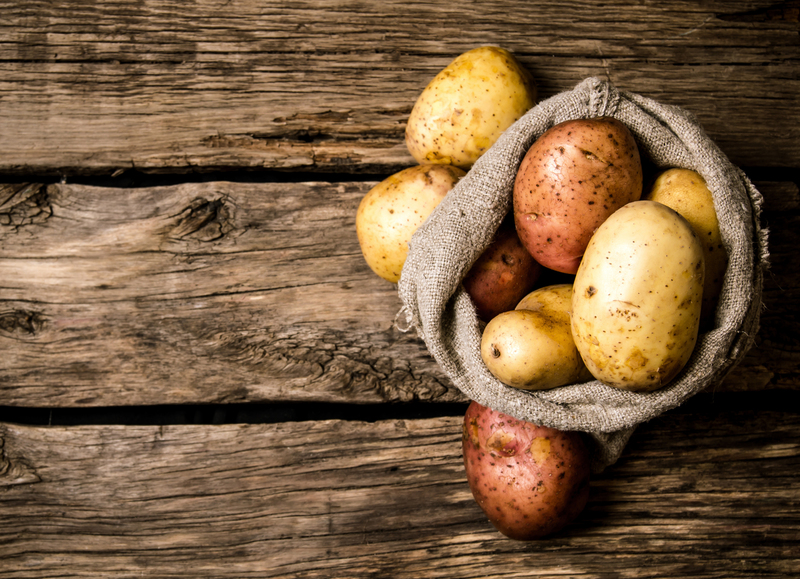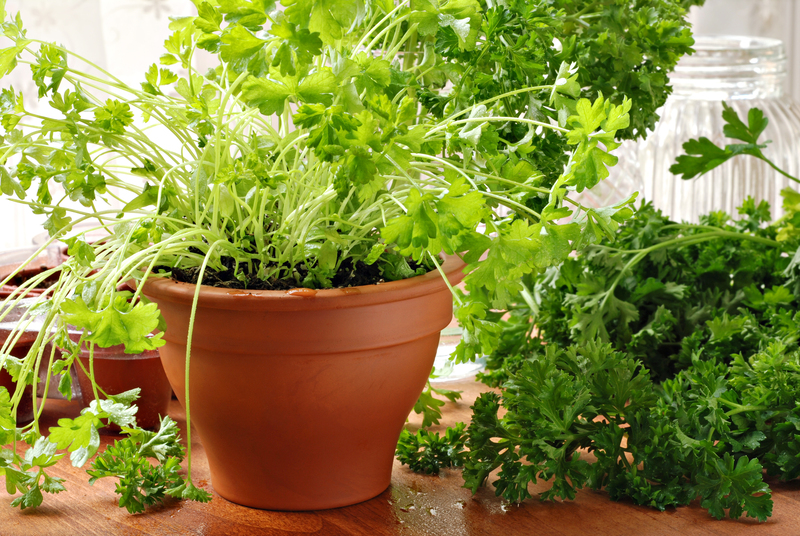Grow Flavorful Herbs with Confidence and Skill
Posted on 18/08/2025
Grow Flavorful Herbs with Confidence and Skill: Your Complete Guide
Do you dream of stepping into your garden or kitchen and snipping fresh, flavorful herbs for your meals? The ability to cultivate herbs at home not only elevates your cuisine but also offers therapeutic, aromatic, and sustainable rewards. Whether you're a novice or an experienced gardener, learning how to grow herbs efficiently is an empowering skill that transforms your cooking and enriches your life. In this comprehensive article, you'll discover expert techniques and insider tips to help you grow flavorful herbs with confidence and skill--right at your fingertips!

Why Grow Your Own Flavorful Herbs?
Cultivating herbs at home goes beyond access to year-round fresh ingredients. Let's explore the many benefits of growing herbs in your own backyard, on a balcony, or even indoors:
- Superior Flavor: Freshly picked herbs are unparalleled in taste, aroma, and vibrancy compared to store-bought alternatives.
- Cost-Effective: A single plant can yield multiple harvests, saving you money on supermarket bundles.
- Healthier Meals: Homegrown herbs are pesticide-free and packed with beneficial nutrients and antioxidants.
- Therapeutic Effects: Gardening can reduce stress, promote mindfulness, and encourage healthy outdoor activity.
- Sustainable Living: Growing your own herbs reduces plastic waste, packaging, and transportation costs.
Imagine garnishing your pasta with a handful of your own basil, or brewing refreshing mint tea from freshly plucked leaves. Empower yourself to cultivate delicious herbs with a sense of pride and accomplishment.
Choosing the Best Herbs to Grow for Maximum Flavor
Are you wondering which herbs are best for beginners or most useful in the kitchen? Here's a selection of easy-to-grow varieties that deliver robust flavor and are excellent starting points for anyone learning to grow flavorful herbs:
Top Ten Flavorful Herbs for Home Gardeners
- Basil: Essential for Italian and Mediterranean dishes; great raw or cooked.
- Parsley (flat-leaf and curly): Versatile in salads, sauces, and garnishes.
- Mint: Fantastic for drinks, desserts, or Middle Eastern cuisine.
- Rosemary: Brings deep aroma to meats, potatoes, and bread.
- Thyme: Elevates soups, stews, and eggs with subtle earthy notes.
- Cilantro (Coriander): Key for Latin, Asian, and Indian recipes.
- Dill: Best for pickling, fish, and creamy sauces.
- Oregano: A backbone for pizzas, pasta, and Greek recipes.
- Chives: Mild onion flavor, ideal in eggs and as a garnish.
- Sage: Delightful in stuffing, roasted vegetables, and with poultry.
These herbs are not only simple to start but also rich in flavor--perfect for transforming the taste of your home-cooked meals.
Selecting the Right Spot for Growing Herbs
To grow herbs with confidence, it's vital to find the ideal location to help your plants thrive. Consider these critical factors for maximum success:
- Sunlight: Most culinary herbs need at least 6 hours of direct sunlight daily. A sunny windowsill, balcony, or garden bed works best.
- Soil Quality: Herbs prefer well-drained, moderately fertile soil. Avoid soggy ground to prevent root rot.
- Air Circulation: Good airflow reduces fungal disease and encourages robust plants.
- Accessibility: The easier it is to reach your herb garden from the kitchen, the more likely you'll use them fresh!
Tip: If outdoor space is limited, don't fret. Many common herbs--like basil, parsley, chives, and mint--thrive in pots on a balcony or sunny window indoors.
Setting Up Your Herb Garden: Soil, Containers & Tools
Soil Preparation for Bold, Flavorful Herbs
Healthy, flavor-rich herbs start with quality soil. Here's how to prepare your ground or containers for growing delicious culinary herbs:
- Test Your Soil: Most herbs grow well in soil with a pH between 6.0 and 7.5.
- Enrich Soil with Compost: Add organic compost or well-rotted manure to boost nutrients.
- Enhance Drainage: Mix sand or perlite into heavy soils or always use pots with drainage holes to avoid waterlogging.
Avoid using only dense, clay-heavy earth, which can suffocate roots and reduce flavor development due to poor aeration.
Choosing Containers for Flavored Herb Success
- Size: Herbs like basil and mint thrive with a minimum 6-8 inch depth.
- Material: Terracotta pots regulate moisture but may dry out faster; plastic pots retain water longer.
- Drainage: Ensure there are holes at the bottom of every container.
Label each container to keep track of your burgeoning herb collection! This practice builds confidence and helps beginners identify their growing herbs at a glance.
Must-Have Tools for Herb Gardeners
- Hand Trowel: Digging and transplanting seedlings
- Watering Can/Spray Bottle: Gentle watering for seedlings and indoor plants
- Pruners or Scissors: Precise harvesting and trimming for bushier growth
- Labels & Markers: Stay organized and skilled as your garden grows!
How to Grow Herbs: Seed, Seedling, or Cutting?
When setting out to grow flavorful herbs with skill, consider whether to start from seed, purchase young plants, or propagate from cuttings:
- Seeds: Cheaper and allow for many plants, but require patience and attention. Herbs like basil, cilantro, and dill are fast growers from seed.
- Seedlings (starts): Ideal for beginners or impatient cooks. Transplant into pots or beds after last frost.
- Cuttings: Mint, basil, oregano, and rosemary are easy to propagate from cuttings. Root them in water until new growth appears, then plant!
Sample Planting Schedule for Culinary Herbs
- Basil, Dill, Cilantro: Sow seeds in spring once frost risk passes.
- Mint, Rosemary, Oregano: Propagate from cuttings or purchase transplants. Plant after last frost.
- Parsley, Sage, Thyme: Start seeds indoors 6-8 weeks before last frost date for an early jumpstart.
Herb Care Essentials: Watering, Feeding, and Pruning
Achieve the confidence and skill to grow strong, flavorful herbs by providing proper care. Here's what your herbs need throughout the season:
Watering Tips for Healthy, Aromatic Herbs
- Consistency Is Key: Most herbs prefer soil that's lightly moist but not drenched. Check moisture with your finger; water when the top inch feels dry.
- Morning Is Best: Water early in the day to prevent disease and allow leaves to dry before nightfall.
- Drainage Matters: Avoid letting pots sit in saucers of water, which suffocates roots and dulls flavor.
Fertilizing Herbs for Robust Growth and Taste
- Less Is More: Unlike vegetables, herbs don't need heavy feeding. Over-fertilizing can produce leafy growth less rich in flavor and aroma.
- Use Balanced, Organic Fertilizers: Compost tea or diluted seaweed solution every few weeks is often perfect.
- Avoid High-Nitrogen Feed: This can make herbs taste weak and reduce their essential oils.
Pruning and Harvesting: The Secret to Vigorous, Flavorful Herbs
- Pinch and Prune Often: Regular trimming encourages bushier growth and more leaves.
- Harvest Early: Pick leaves in the morning for peak oil content and flavor.
- Don't Strip Entire Stems: Always leave some leaves for energy and regrowth. Never remove more than 1/3 of the plant at one time.
Pro Tip: For maximum flavor, allow perennial herbs like thyme or oregano to mature for a few months before your first major harvest!
Overcoming Common Challenges in Herb Gardening
Every gardener encounters surprises, but you can avoid major pitfalls and feel empowered to grow delicious herbs with these preventative strategies:
- Pests: Aphids, whiteflies, and spider mites can affect herbs. Encourage ladybugs or spray with a mild soap solution.
- Disease: Good air circulation and proper watering prevent mildew and rot.
- Bolting: Herbs like cilantro and basil may bolt (go to seed) in hot weather; harvest regularly and provide partial shade in midsummer.
- Leggy Growth: Insufficient sunlight results in tall, spindly plants. Relocate to a sunnier spot or supplement with a grow light indoors.
- Flavor Loss: Over-fertilizing, infrequent harvesting, or excessive watering can lead to bland herbs. Stick to best practices for the boldest taste!
Maximize Herb Flavor: Advanced Tips and Tricks
Ready to take your herb-growing skills to the next level? Here are advanced solutions for intensifying the flavor and aroma of your plants:
- Stagger Plantings: Sow seeds a few weeks apart for steady harvests through the season.
- Prune Flower Buds: For herbs like basil and mint, remove flower spikes as soon as they appear to maintain leaf production and peak flavor.
- Mulch Smartly: Use a light mulch (like straw or bark) to keep soil moisture even--but avoid mulching right to the stem to prevent rot.
- Rotate Herbs: Relocate pots or garden beds yearly to prevent disease buildup and nutrient deficiencies.
- Grow Companions: Certain herbs--like basil and tomatoes, or rosemary and beans--can boost each other's health and enhance nearby flavor.

Harvesting, Preserving, and Using Your Flavorful Herbs
Harvesting Techniques for Peak Freshness
- Basil, Mint, and Parsley: Harvest leaf tips regularly to encourage bushiness.
- Thyme, Rosemary, Sage: Snip off woody stems where new growth appears.
- Chives: Cut leaves at soil level for a constant supply.
Preserving Your Harvest
Got more herbs than you can use fresh? Here's how to preserve culinary herbs:
- Drying: Tie small bunches and hang upside-down in a dry, shaded location. Once crumbly, store in airtight jars away from light.
- Freezing: Chop herbs and freeze in ice cube trays with a splash of water or oil for immediate use in soups, sauces, or roasts.
- Herb Butters & Oils: Blend with softened butter or olive oil and freeze for long-term flavor boosts.
Creative Culinary Uses for Homegrown Herbs
- Make Infused Vinegars and Oils: Add sprigs of rosemary or basil for gourmet dressings.
- Brew Herbal Teas: Mint, lemon balm, and chamomile excel in soothing drinks.
- Dress Up Desserts and Cocktails: Basil and mint are popular additions to fruit salads, cocktails, and even desserts.
- Flavored Salts & Seasonings: Mix dried herbs with sea salt for homemade gifts or unique pantry staples.
Conclusion: Cultivate Confidence and Skill with Flavorful Herbs
Growing your own flavorful herbs is a rewarding journey that begins with a single seed and grows into a daily source of pride, health, and culinary adventure. By following these expert tips--offering the right blend of sunlight, soil, water, and regular harvesting--you'll quickly learn how to grow herbs skillfully, even if you're starting from scratch.
With the confidence and skill gained from hands-on experience, you can transform every meal into a gourmet delight using fresh, aromatic herbs right from your garden or windowsill. So dig in--start your herb garden today and unlock a world of flavor!

